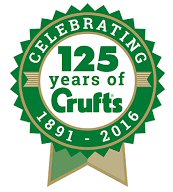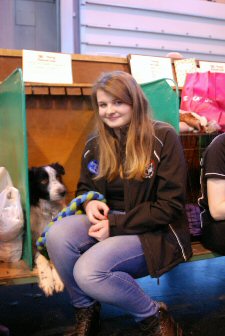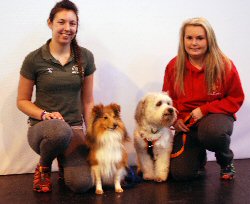How the top competitors manage performance
anxiety
 Competition nerves and
performance anxiety affect most agility competitors at some point during their
agility career. Kaye Medcalf went as a reporter for Agilitynet to Crufts, to
find out the techniques the top young handlers and Championship competitors have
for managing the pressures of competing, especially in front of large
audiences... Competition nerves and
performance anxiety affect most agility competitors at some point during their
agility career. Kaye Medcalf went as a reporter for Agilitynet to Crufts, to
find out the techniques the top young handlers and Championship competitors have
for managing the pressures of competing, especially in front of large
audiences...
'Can you move up the
seating isle if there are any spare seats, we have people queueing outside,' the
commentator announces to the morning crowd waiting eagerly to see the
Championship Jumping and Agility in the main arena of Crufts 2016. The 6,000
stalls filled to capacity and towering above the ring is a terrifyingly large
crowd to compete in front of, even at Championship level where you are used to a
small crowd gathering around the ring. I wonder how these top competitors deal
with the anxieties and nerves most handlers face even when not exacerbated by
6,000 people watching you.
 In between the Jumping
and Agility Championship runs, I venture out into the holding stalls to see if I
can find answers, but most politely decline to be interviewed, explaining that
they need to prepare for the upcoming agility course. A few are sat with friends
chatting, others are busy with their dogs, while some sit on the floor silently
staring at the course plans in front of them. Undeterred I seek out the Young
Kennel Club (YKC) ring to talk to the rising stars of the agility world about
how they handle competition anxiety and the pressures of competing at the
largest dog show in the world. In between the Jumping
and Agility Championship runs, I venture out into the holding stalls to see if I
can find answers, but most politely decline to be interviewed, explaining that
they need to prepare for the upcoming agility course. A few are sat with friends
chatting, others are busy with their dogs, while some sit on the floor silently
staring at the course plans in front of them. Undeterred I seek out the Young
Kennel Club (YKC) ring to talk to the rising stars of the agility world about
how they handle competition anxiety and the pressures of competing at the
largest dog show in the world.
Talking to competitors
The YKC ring does not
have the luxury of the few meters of separation between the ring and seating
that the main arena offers. Instead the large crowd is right up against the
small fence marking out the arena, with the agility drawing crowds large enough
to nearly block off entire walk ways on all sides. You can hardly see the ring
through the throng of people around it.
The first people I speak
to are the Nedlo Dream Team - aka Abby Blyth, Holly Ryan, Katy Phillips, Jack
Ryan and Lara Browne - YKC Dog of the Year winner 2015 & 2016. The Nedlo Dream
Team came 3rd in this yearís YKC team Agility and won the same event
last year, so have proven themselves to be able to deal with the pressures of
competing at Crufts in the public eye - pressures which many others would cave
under.
 Lara
bravely pushes aside any mention of nerves, explaining that she had been to
Crufts before, while Katy reflects that she finds it most helpful to concentrate
on the dog rather than herself, and gains confidence from knowing the course.
Their enthusiasm for the sport shines through. Lara
bravely pushes aside any mention of nerves, explaining that she had been to
Crufts before, while Katy reflects that she finds it most helpful to concentrate
on the dog rather than herself, and gains confidence from knowing the course.
Their enthusiasm for the sport shines through.
'Itís really fun and
you make new friends: both dog and human,' remarks Jack. It is clear that
camaraderie and team spirit are key to this dynamic group as can be seen by
their matching shirts, entourage of support and display of good luck cards.
Oliver Key, who handles
his dog Blue in the North Derbyshire Agility Club YKC team (placed 5th),
tells me that the best way to overcome nerves is: 'You just have to run, block
it out really.'
Another YKC member called Hannah says she gets
nervous all the time when competing and recommends focusing on enjoying the
experience. She adds that you will get used to it with time and practise.
 The final YKC
competitors I speak to are in the 18-24 jumping competition Chloe Brown with her
dog Tye (placed 2nd) and Amy Bingham with her dog Dylan. When asked
if they ever get nervous, they both laugh and agree. Amy mentions that she gets
'really nervous,' while Chloe adds 'Itís all right until you start walking the
course, and then it gets to you that you are about to run in front of all the
people.' The final YKC
competitors I speak to are in the 18-24 jumping competition Chloe Brown with her
dog Tye (placed 2nd) and Amy Bingham with her dog Dylan. When asked
if they ever get nervous, they both laugh and agree. Amy mentions that she gets
'really nervous,' while Chloe adds 'Itís all right until you start walking the
course, and then it gets to you that you are about to run in front of all the
people.'
Chloe feels that she doesn't have any set techniques for dealing with
competition nerves but tries to concentrate on the course, while Amyís strategy
is to not watch the other competitors running. Again support from each other,
and support from friends and family in the form of good luck cards proudly
displayed on the benches they have turned into a home for the day, seems to be a
source of comfort and support for these two top young agility competitors.
Back at the Championship
competitor stalls, I talked with Sue Cooper, former GB Team competitor, winner of the Crufts
2016 Championship Jumping, and who would later place 4th in the
Championship finals with Mitzi (Blackthorns Speedy Mitzi). They were riding
on the high of getting into the finals after receiving 5 faults in the Agility.
She speaks enthusiastically about how it is not just the human competitors who
get nervous, but dogs too: 'Obviously there a lot more people around [at
Crufts], some of the dogs are okay with that and some dogs canít cope with it.
Mitzi is a little bit over the top. She copes with it really well.'
 Speaking of
her own battles with nerves, Sue commented that: 'I do suffer from my nerves.
Thatís my downfall sometimes. I was very nervous of my first round, the Jumping
round, but, once that was over, I was fine. My legs feel like jelly on the start
line, but once you go thatís it. The adrenaline kicks in and you are off and
away.' Speaking of
her own battles with nerves, Sue commented that: 'I do suffer from my nerves.
Thatís my downfall sometimes. I was very nervous of my first round, the Jumping
round, but, once that was over, I was fine. My legs feel like jelly on the start
line, but once you go thatís it. The adrenaline kicks in and you are off and
away.'
To deal with her nerves Sueís personal strategy is: 'I concentrate on the
course and then go over it in my mind, over and over again. I close my eyes. I
view myself actually traversing the course in my head. I concentrate on that
quite a lot.'
How to cope
It is clear that the
specific techniques for dealing with competition nerves are as varied as the
large variety of people competing in agility across the world. However, from
those at the top of their game in the current Championships, to the next
generation of champions who are only just beginning to show us what they can
achieve, there seems to be several basic themes in common:
-
Firstly, support
from fellow competitors, family and friends: whether they are there during
the competition or only present in the form of cards wishing good luck, the
support from others seems to be key to creating a relaxed atmosphere and
forming a supportive base that gives competitors the chance to step outside
their comfort zone knowing they are not alone.
-
Secondly, memorising
and visualising the course until competitors are confident in their
knowledge of what they have to do to succeed. Mimicking the turns and body
language competitors need to replicate in the ring, while visualising the
course can help create 'muscle memory' which results in faster reactions in
the ring.
-
Finally,
concentrating on what is most important - your dog.
When asked what their
favourite part of agility was nearly every YKC member mentioned spending time
and having fun with their dog and, as Sue Cooper, pointed out it is not only
human competitors who feel nervous. Everyone starts out in agility for the same
reason -to have fun with their best friend. Competitions, no matter how big or
small, are just a chance to have a fantastic game of agility with your dog who
does not care whether you get eliminated or placed first as long as itís fun,
while you get to show everyone else what you already know - just how amazing your
best furry friend is.
 About the author... About the author...
Kaye Medcalf has been competing in agility since he was 12
years old and reached Championship level with his sisterís dog Pixie, and Grade
6 with his own dog Holly. He competed at Crufts in the YKC ring on two occasions
Ė winning the YKC Medium Agility in 2008, before Holly had to retire due to
illness.
Kaye and Holly are now
enjoying Hollyís old age/golden years together. Their favourite thing is long
walks with Hollyís buggy (aka the princessmobile) in case she gets tired.
Kaye
is an Agility Club accredited trainer and judge.
First published 31
March 2016
|